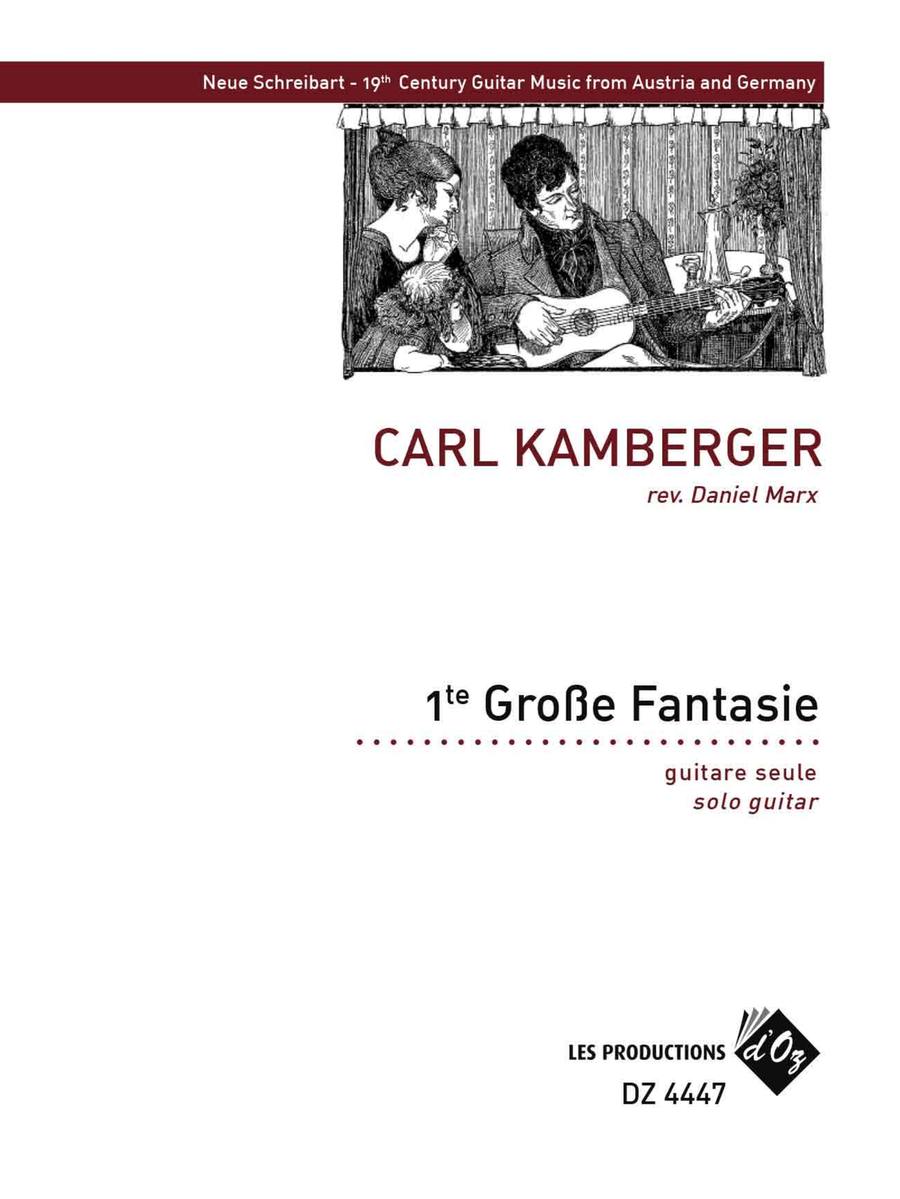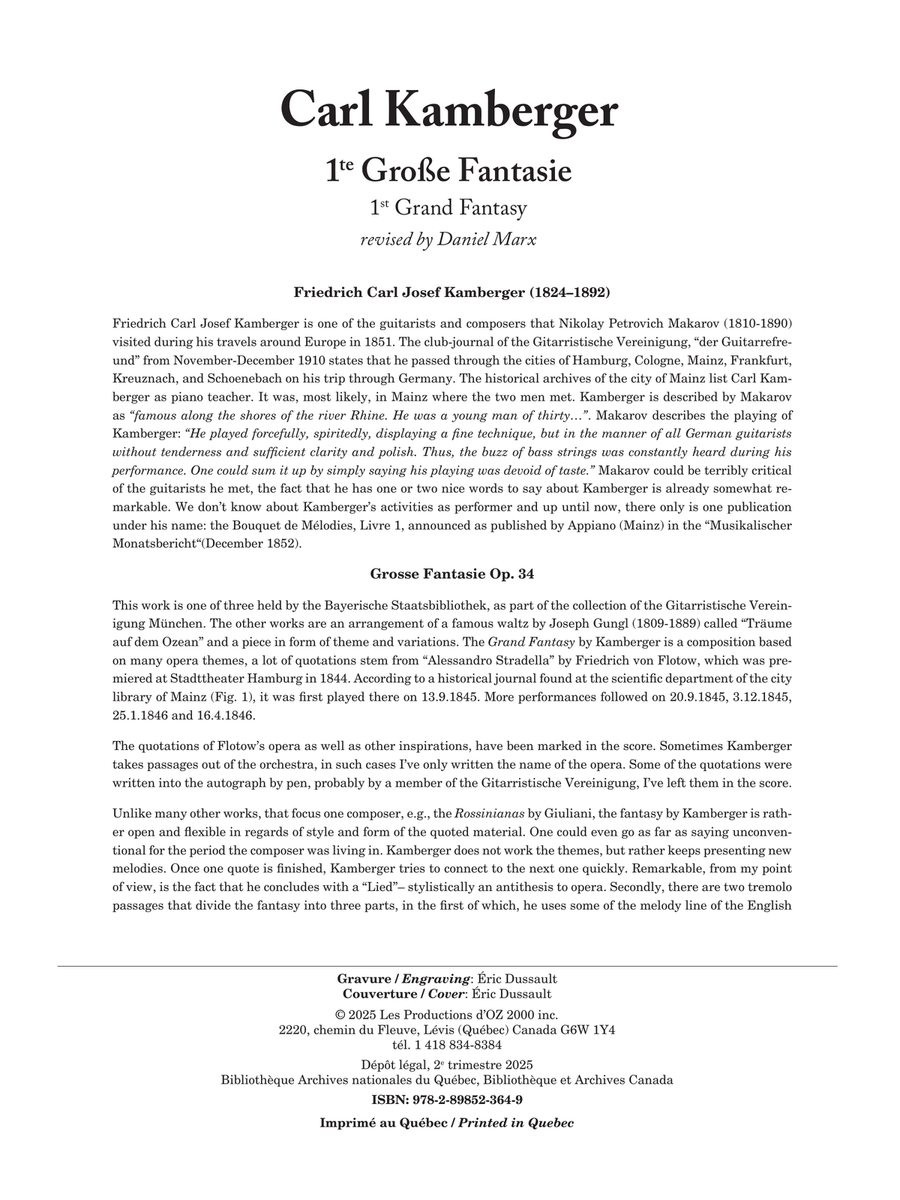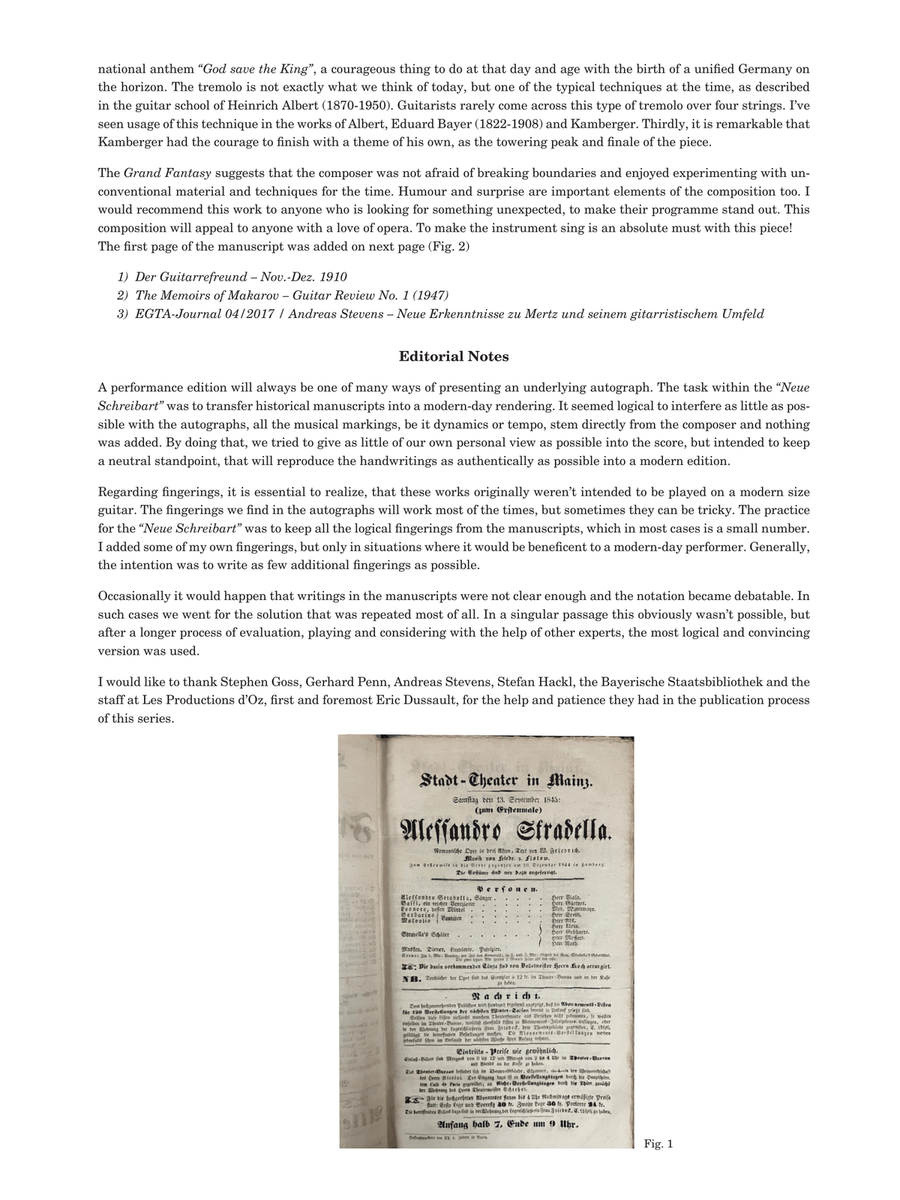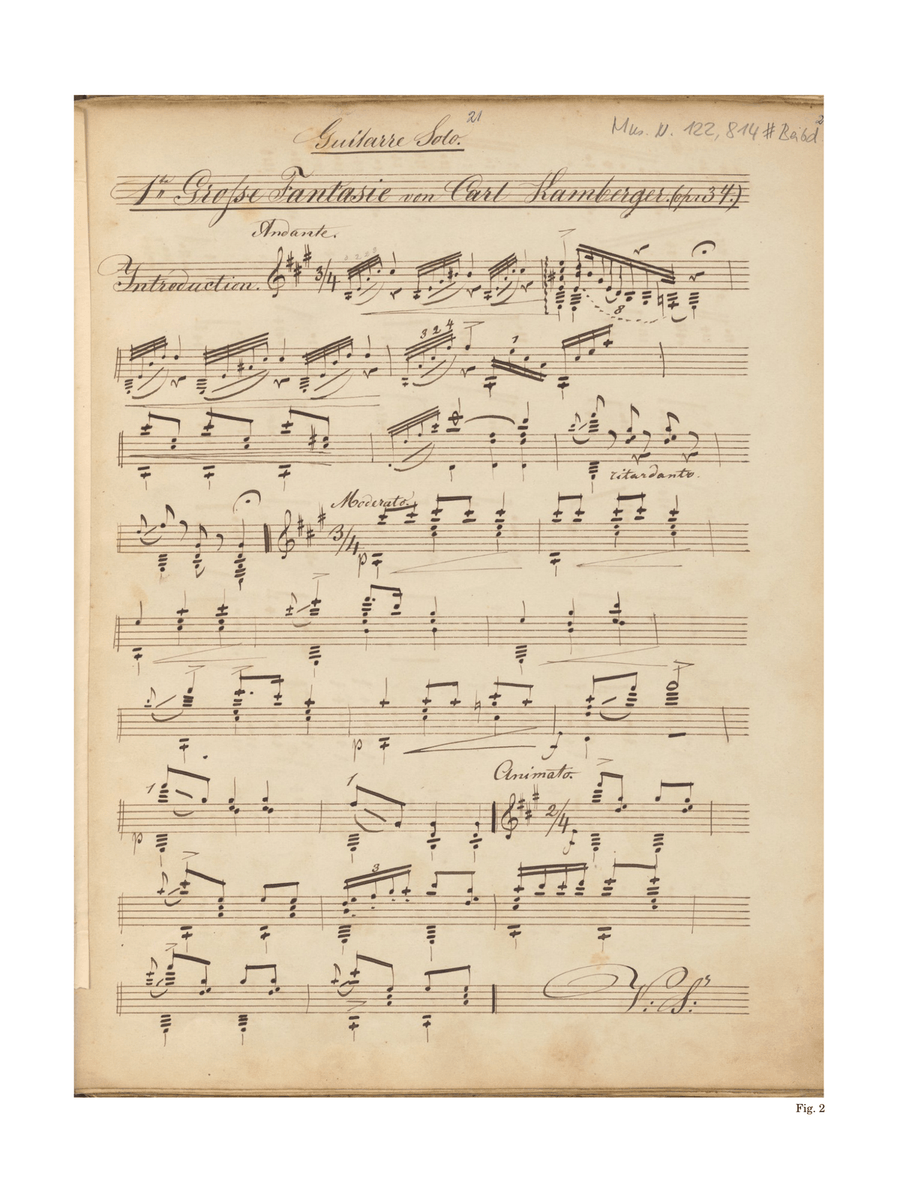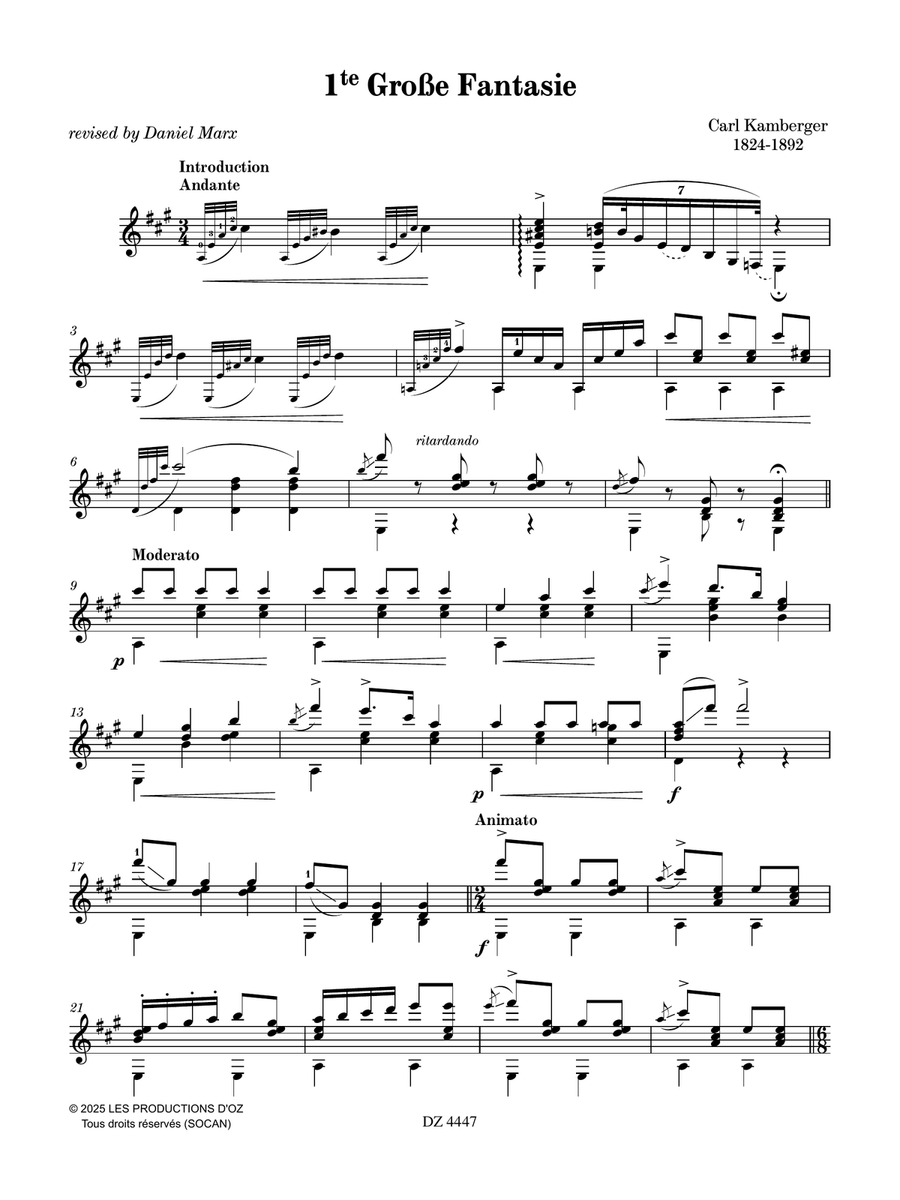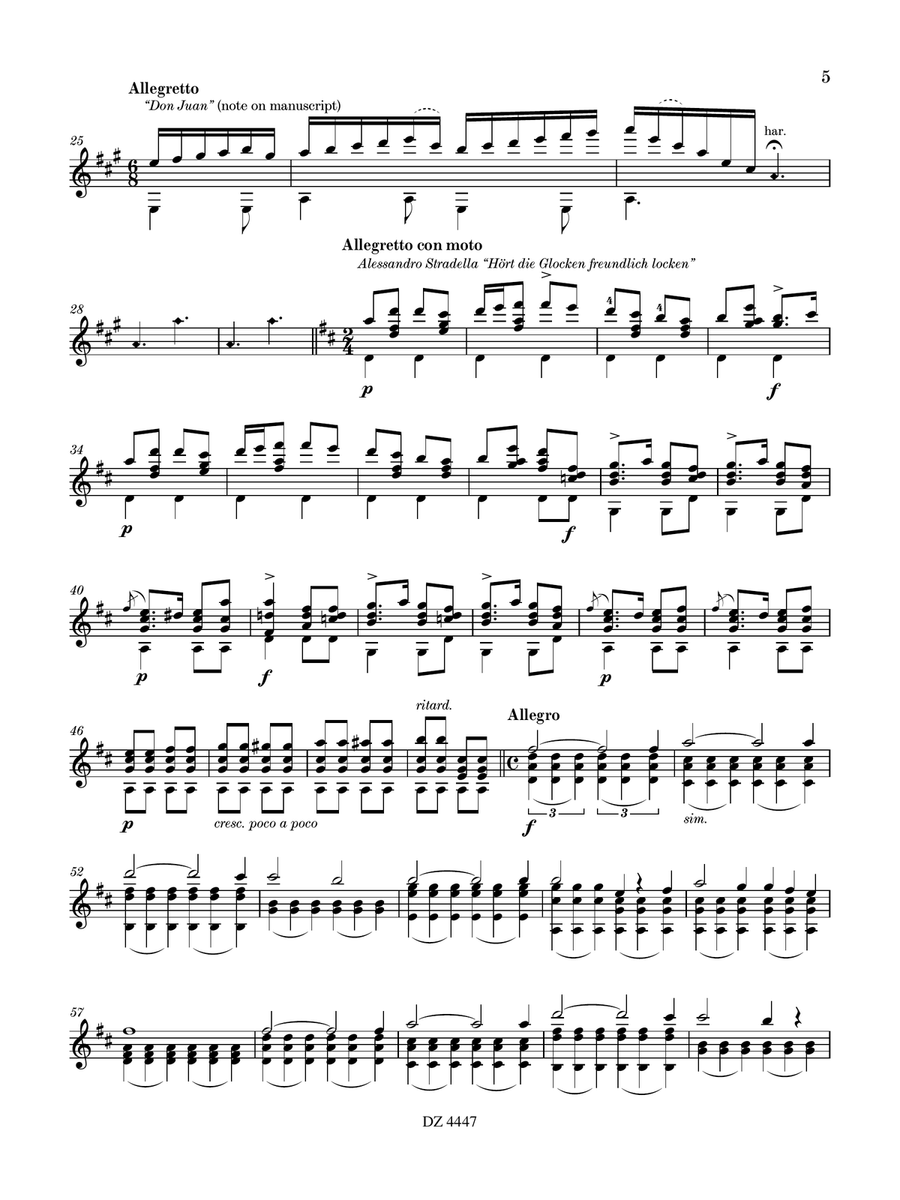Guitar - Advanced - Digital Download
SKU: ZZ.DZ-4447
Composed by Karl KAMBERGER. Arranged by Daniel Marx. Les Productions d'OZ - Digital #DZ 4447. Published by Les Productions d'OZ - Digital (ZZ.DZ-4447).
ISBN 9782898523649.
This work is one of three held by the Bayerische Staatsbibliothek, as part of the collection of the Gitarristische Vereinigung München. The other works are an arrangement of a famous waltz by Joseph Gungl (1809-1889) called "Träume auf dem Ozean" and a piece in form of theme and variations. The Grand Fantasy by Kamberger is a composition based on many opera themes, a lot of quotations stem from "Alessandro Stradella" by Friedrich von Flotow, which was premiered at Stadttheater Hamburg in 1844. According to a historical journal found at the scientific department of the city library of Mainz, it was first played there on 13.9.1845. More performances followed on 20.9.1845, 3.12.1845, 25.1.1846 and 16.4.1846.
The quotations of Flotow’s opera as well as other inspirations, have been marked in the score. Sometimes Kamberger takes passages out of the orchestra, in such cases I’ve only written the name of the opera. Some of the quotations were written into the autograph by pen, probably by a member of the Gitarristische Vereinigung, I’ve left them in the score.
Unlike many other works, that focus one composer, e.g., the Rossinianas by Giuliani, the fantasy by Kamberger is rather open and flexible in regards of style and form of the quoted material. One could even go as far as saying unconventional for the period the composer was living in. Kamberger does not work the themes, but rather keeps presenting new melodies. Once one quote is finished, Kamberger tries to connect to the next one quickly. Remarkable, from my point of view, is the fact that he concludes with a "Lied"– stylistically an antithesis to opera. Secondly, there are two tremolo passages that divide the fantasy into three parts, in the first of which, he uses some of the melody line of the English national anthem "God save the King", a courageous thing to do at that day and age with the birth of a unified Germany on the horizon. The tremolo is not exactly what we think of today, but one of the typical techniques at the time, as described in the guitar school of Heinrich Albert (1870-1950). Guitarists rarely come across this type of tremolo over four strings. I’ve seen usage of this technique in the works of Albert, Eduard Bayer (1822-1908) and Kamberger. Thirdly, it is remarkable that Kamberger had the courage to finish with a theme of his own, as the towering peak and finale of the piece.
The Grand Fantasy suggests that the composer was not afraid of breaking boundaries and enjoyed experimenting with unconventional material and techniques for the time. Humour and surprise are important elements of the composition too. I would recommend this work to anyone who is looking for something unexpected, to make their programme stand out. This composition will appeal to anyone with a love of opera. To make the instrument sing is an absolute must with this piece!
Cette œuvre est l'une des trois conservées par la Bayerische Staatsbibliothek, au sein de la collection de la Gitarristische Vereinigung München (Association de guitare de Munich). Les autres œuvres sont un arrangement d'une célèbre valse de Joseph Gungl (1809-1889) intitulée « Träume auf dem Ozean » (Rêves sur l'océan) et une pièce sous forme de thème et variations. La Grande Fantaisie de Kamberger est une composition basée sur de nombreux thèmes d'opéra, dont beaucoup de citations proviennent d'« Alessandro Stradella » de Friedrich von Flotow, qui fut créé au Stadttheater de Hambourg en 1844. Selon un journal historique trouvé au département scientifique de la bibliothèque municipale de Mayence, elle y fut jouée pour la première fois le 13 septembre 1845. D'autres représentations suivirent les 20 septembre 1845, 3 décembre 1845, 25 janvier 1846 et 16 avril 1846.
Les citations de l'opéra de Flotow ainsi que d'autres inspirations ont été marquées dans la partition. Parfois, Kamberger reprend des passages de l'orchestre ; dans ces cas, j'ai seulement indiqué le nom de l'opéra. Certaines des citations ont été écrites à la plume dans l'autographe, probablement par un membre de la Gitarristische Vereinigung; je les ai laissées dans la partition.
Contrairement à de nombreuses autres œuvres qui se concentrent sur un seul compositeur, comme les Rossinianes de Giuliani, la fantaisie de Kamberger est plutôt ouverte et flexible en ce qui concerne le style et la forme du matériel cité. On pourrait même aller jusqu'à dire qu'elle est non conventionnelle pour l'époque où vivait le compositeur. Kamberger ne travaille pas les thèmes, mais continue plutôt de présenter de nouvelles mélodies. Une fois une citation terminée, Kamberger essaie de passer rapidement à la suivante. Remarquable, de mon point de vue, est le fait qu'il conclut par un « Lied » – stylistiquement une antithèse de l'opéra. Deuxièmement, il y a deux passages de trémolo qui divisent la fantaisie en trois parties, dans la première desquelles il utilise une partie de la ligne mélodique de l'hymne national anglais « God save the King », une chose courageuse à faire à cette époque avec la naissance d'une Allemagne unifiée à l'horizon. Le trémolo n'est pas exactement ce que nous en pensons aujourd'hui, mais l'une des techniques typiques de l'époque, comme décrit dans la méthode de guitare de Heinrich Albert (1870-1950). Les guitaristes rencontrent rarement ce type de trémolo sur quatre cordes. J'ai vu l'utilisation de cette technique dans les œuvres d'Albert, d'Eduard Bayer (1822-1908) et de Kamberger. Troisièmement, il est remarquable que Kamberger ait eu le courage de terminer par un thème de sa propre composition, comme point culminant et finale de la pièce.
La Grande Fantaisie suggère que le compositeur n'avait pas peur de briser les frontières et aimait expérimenter avec des matériaux et des techniques non conventionnels pour l'époque. L'humour et la surprise sont également des éléments importants de la composition. Je recommanderais cette œuvre à quiconque recherche quelque chose d'inattendu pour faire ressortir son programme. Cette composition plaira à tous ceux qui aiment l'opéra. Faire chanter l'instrument est un impératif absolu avec cette pièce!
Digital Downloads are downloadable sheet music files that can be viewed directly on your computer, tablet or mobile device. Once you download your digital sheet music, you can view and print it at home, school, or anywhere you want to make music, and you don’t have to be connected to the internet. Just purchase, download and play!
PLEASE NOTE: Your Digital Download will have a watermark at the bottom of each page that will include your name, purchase date and number of copies purchased. You are only authorized to print the number of copies that you have purchased. You may not digitally distribute or print more copies than purchased for use (i.e., you may not print or digitally distribute individual copies to friends or students).
